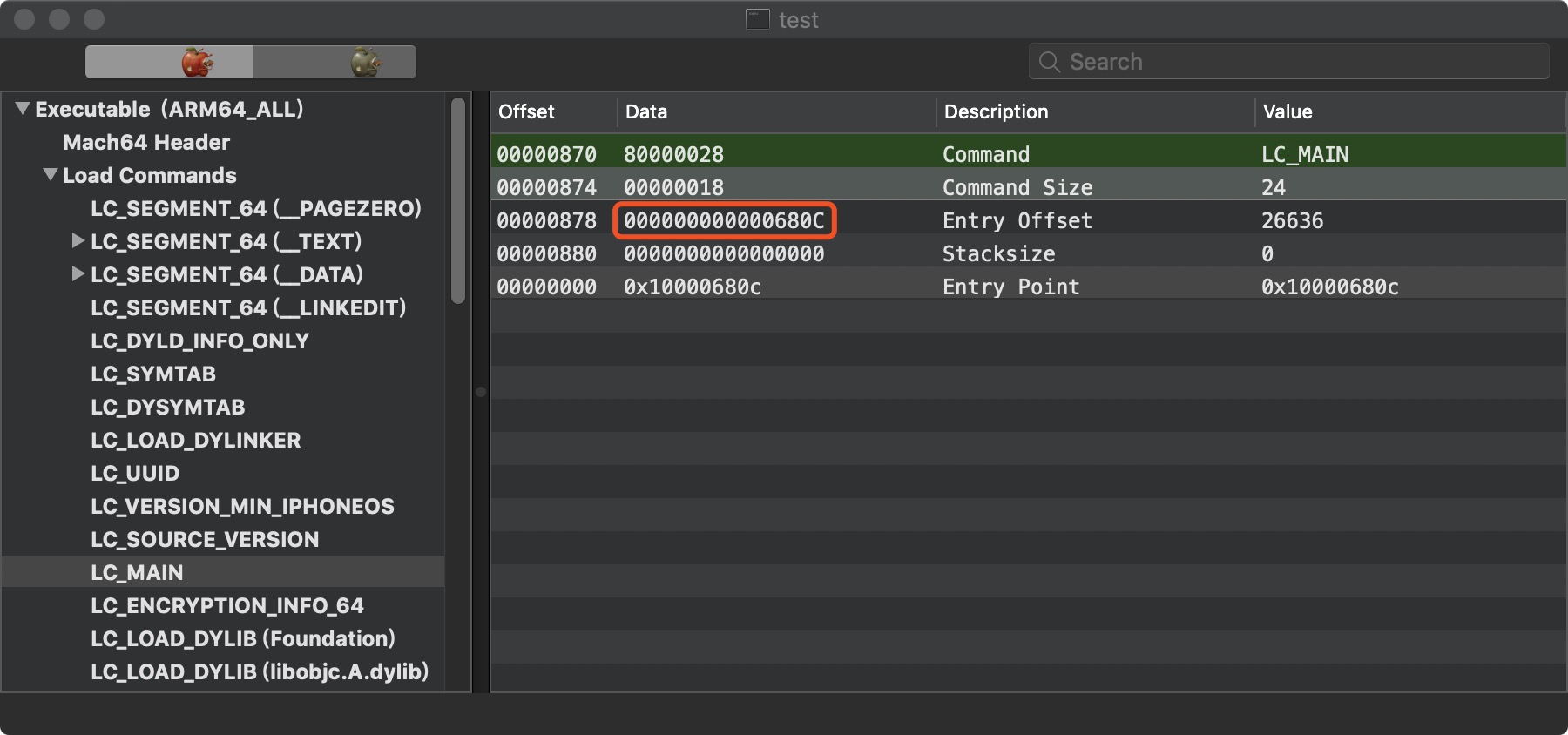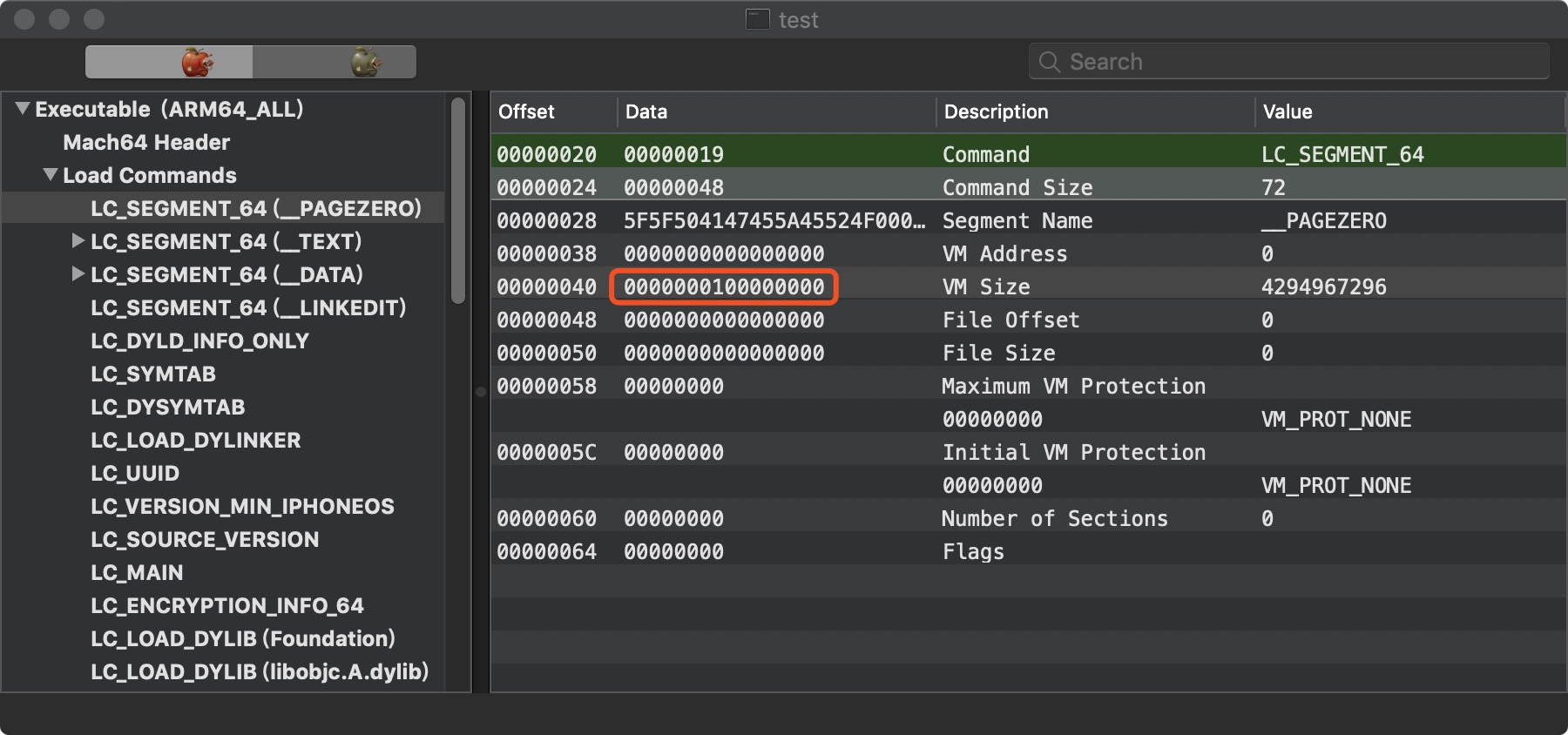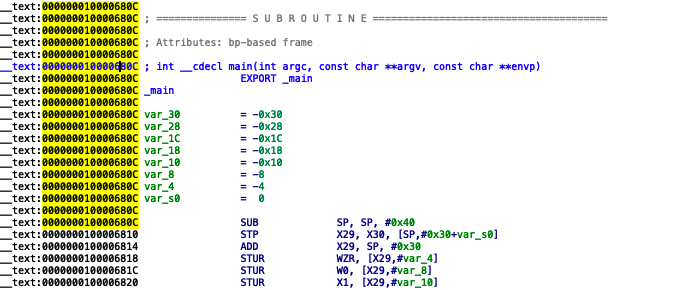dyld 源码初探
By dwj1210 at
写在前面
在开发过程中我们看到的程序入口都是 main 函数,所以认为程序都是从 main 函数开始执行的。其实在程序执行 main 函数之前已经执行了 +load 和 constructor 构造函数。今天我们就来看看在 main 函数执行之前都发生了什么。
什么是 dyld ?
程序运行依赖于很多动态库,动态库也是一个静态文件,格式和 iOS、MacOS、WatchOS 的可执行文件格式是一样的,都是 Mach-O 文件。他本身是不可以直接运行的,需要通过一个动态库加载器将其加载到内存空间,那么这个动态链接加载器就是 dyld 了。
dyld 源码分析
dyld 在手机中的路径是 /usr/lib/dyld,这是源码下载地址 dyld源码 。
代码从 dyldStartup.s 文件开始执行,下面我们看看用汇编实现的 __dyld_start 方法。
#if __arm64__
...省略代码...
// __ZN13dyldbootstrap5startEPK12macho_headeriPPKclS2_Pm 是被 name mangling 过的 c++ 函数(不明白什么是 name mangling 的可以谷歌一下 C++ 中的 name mangling)。
// 实际调用就是 dyldbootstrap::start(macho_header const*,int,char const**,long,macho_header const*,ulong *),此函数的调用会完成动态库加载的一系列过程,并返回主程序 main 函数的地址,保存在 x0 寄存器。
bl __ZN13dyldbootstrap5startEPK12macho_headeriPPKclS2_Pm
// 将主程序 main 函数的地址存入 x16 寄存器
mov x16,x0
ldr x1, [sp]
cmp x1, #0
// 调用 b.ne Lnew 进行准备入参,环境变量等
b.ne Lnew
// LC_UNIXTHREAD way, clean up stack and jump to result
add sp, x28, #8 // restore unaligned stack pointer without app mh
// 跳转主程序 main 函数,也就是我们 App 中的 mian 函数被调用
br x16
// LC_MAIN case, set up stack for call to main()
Lnew: mov lr, x1 // simulate return address into _start in libdyld.dylib
ldr x0, [x28, #8] // main param1 = argc
add x1, x28, #16 // main param2 = argv
add x2, x1, x0, lsl #3
add x2, x2, #8 // main param3 = &env[0]
mov x3, x2
...省略代码...
#endif // __arm64__我们看到在 __dyld_start 中调用了 dyldbootstrap::start 。下面我们就看看 dyldbootstrap::start 做了什么:
uintptr_t start(const struct macho_header* appsMachHeader, int argc, const char* argv[],
intptr_t slide, const struct macho_header* dyldsMachHeader,
uintptr_t* startGlue)
{
// if kernel had to slide dyld, we need to fix up load sensitive locations
// we have to do this before using any global variables
// 通过 kernel 传过来的 slieds 修正 dyld 的 non-lazy 符号地址,因为 dyld 有了 ASLR ,所以符号也都需要根据 ASLR 做偏移,lazy 的符号因为其动态库已经做了改作的偏移不需要处理。
if ( slide != 0 ) {
rebaseDyld(dyldsMachHeader, slide);
}
// allow dyld to use mach messaging
// 消息初始化
mach_init();
// kernel sets up env pointer to be just past end of agv array
const char** envp = &argv[argc+1];
// kernel sets up apple pointer to be just past end of envp array
const char** apple = envp;
while(*apple != NULL) { ++apple; }
++apple;
// set up random value for stack canary
// 栈溢出保护
__guard_setup(apple);
#if DYLD_INITIALIZER_SUPPORT
// run all C++ initializers inside dyld
runDyldInitializers(dyldsMachHeader, slide, argc, argv, envp, apple);
#endif
// now that we are done bootstrapping dyld, call dyld's main
uintptr_t appsSlide = slideOfMainExecutable(appsMachHeader);
// 此函数的调用会完成动态库加载的一系列过程,并返回主程序 main 函数入口,也就是 App 中的 main 函数地址
return dyld::_main(appsMachHeader, appsSlide, argc, argv, envp, apple, startGlue);
}上面看到了调用 dyld::_main 函数,其实在该函数中便完成了整个动态库加载的一系列过程,接下来我们仔细看看中间都做了什么:
uintptr_t
_main(const macho_header* mainExecutableMH, uintptr_t mainExecutableSlide,
int argc, const char* argv[], const char* envp[], const char* apple[],
uintptr_t* startGlue)
{
uintptr_t result = 0;
// 保存执行文件头部,后续可以根据头部访问其他信息
sMainExecutableMachHeader = mainExecutableMH;
#if __MAC_OS_X_VERSION_MIN_REQUIRED
// if this is host dyld, check to see if iOS simulator is being run
const char* rootPath = _simple_getenv(envp, "DYLD_ROOT_PATH");
if ( rootPath != NULL ) {
// Add dyld to the kernel image info before we jump to the sim
notifyKernelAboutDyld();
// look to see if simulator has its own dyld
char simDyldPath[PATH_MAX];
strlcpy(simDyldPath, rootPath, PATH_MAX);
strlcat(simDyldPath, "/usr/lib/dyld_sim", PATH_MAX);
int fd = my_open(simDyldPath, O_RDONLY, 0);
if ( fd != -1 ) {
const char* errMessage = useSimulatorDyld(fd, mainExecutableMH, simDyldPath, argc, argv, envp, apple, startGlue, &result);
if ( errMessage != NULL )
halt(errMessage);
return result;
}
}
#endif
CRSetCrashLogMessage("dyld: launch started");
// 设置上下文信息
setContext(mainExecutableMH, argc, argv, envp, apple);
// Pickup the pointer to the exec path.
// 获取可执行文件路径
sExecPath = _simple_getenv(apple, "executable_path");
// <rdar://problem/13868260> Remove interim apple[0] transition code from dyld
if (!sExecPath) sExecPath = apple[0];
// 将相对路径转成绝对路径
if ( sExecPath[0] != '/' ) {
// have relative path, use cwd to make absolute
char cwdbuff[MAXPATHLEN];
if ( getcwd(cwdbuff, MAXPATHLEN) != NULL ) {
// maybe use static buffer to avoid calling malloc so early...
char* s = new char[strlen(cwdbuff) + strlen(sExecPath) + 2];
strcpy(s, cwdbuff);
strcat(s, "/");
strcat(s, sExecPath);
sExecPath = s;
}
}
// Remember short name of process for later logging
// 获取文件的名字
sExecShortName = ::strrchr(sExecPath, '/');
if ( sExecShortName != NULL )
++sExecShortName;
else
sExecShortName = sExecPath;
// 配置进程是否受限
configureProcessRestrictions(mainExecutableMH);
#if __MAC_OS_X_VERSION_MIN_REQUIRED
if ( gLinkContext.processIsRestricted ) {
pruneEnvironmentVariables(envp, &apple);
// set again because envp and apple may have changed or moved
setContext(mainExecutableMH, argc, argv, envp, apple);
}
else
#endif
{
// 检查设置环境变量
checkEnvironmentVariables(envp);
// 如果 DYLD_FALLBACK 为 nil,将其设置为默认值
defaultUninitializedFallbackPaths(envp);
}
// 处理环境变量,如果我们在 xcode 中的 Edit Scheme -> run -> Argument 中添加了 DYLD_PRINT_OPTS、DYLD_PRINT_ENV 等参数,可在输出打印相关信息
if ( sEnv.DYLD_PRINT_OPTS )
printOptions(argv);
if ( sEnv.DYLD_PRINT_ENV )
printEnvironmentVariables(envp);
// 获取当前运行架构的信息
getHostInfo(mainExecutableMH, mainExecutableSlide);
// install gdb notifier
stateToHandlers(dyld_image_state_dependents_mapped, sBatchHandlers)->push_back(notifyGDB);
stateToHandlers(dyld_image_state_mapped, sSingleHandlers)->push_back(updateAllImages);
// make initial allocations large enough that it is unlikely to need to be re-alloced
sImageRoots.reserve(16);
sAddImageCallbacks.reserve(4);
sRemoveImageCallbacks.reserve(4);
sImageFilesNeedingTermination.reserve(16);
sImageFilesNeedingDOFUnregistration.reserve(8);
#if !TARGET_IPHONE_SIMULATOR
#ifdef WAIT_FOR_SYSTEM_ORDER_HANDSHAKE
// <rdar://problem/6849505> Add gating mechanism to dyld support system order file generation process
WAIT_FOR_SYSTEM_ORDER_HANDSHAKE(dyld::gProcessInfo->systemOrderFlag);
#endif
#endif
try {
// add dyld itself to UUID list
addDyldImageToUUIDList();
notifyKernelAboutDyld();
#if SUPPORT_ACCELERATE_TABLES
bool mainExcutableAlreadyRebased = false;
reloadAllImages:
#endif
CRSetCrashLogMessage(sLoadingCrashMessage);
// instantiate ImageLoader for main executable
// 作为主程序初始化 imageLoader,用于后续的链接等过程,主程序作为 dyld 的第一个被 addimage 的镜像,所以我们总是能够通过 _dyld_get_image_header(0) 或者 _dyld_get_image_name(0) 等,索引到第一个 image 镜像作为主程序的相关信息。
// 加载可执行文件,并生成一个 ImageLoader 实例对象
sMainExecutable = instantiateFromLoadedImage(mainExecutableMH, mainExecutableSlide, sExecPath);
gLinkContext.mainExecutable = sMainExecutable;
gLinkContext.mainExecutableCodeSigned = hasCodeSignatureLoadCommand(mainExecutableMH);
#if TARGET_IPHONE_SIMULATOR
// check main executable is not too new for this OS
{
if ( ! isSimulatorBinary((uint8_t*)mainExecutableMH, sExecPath) ) {
throwf("program was built for a platform that is not supported by this runtime");
}
uint32_t mainMinOS = sMainExecutable->minOSVersion();
// dyld is always built for the current OS, so we can get the current OS version
// from the load command in dyld itself.
uint32_t dyldMinOS = ImageLoaderMachO::minOSVersion((const mach_header*)&__dso_handle);
if ( mainMinOS > dyldMinOS ) {
#if TARGET_OS_WATCH
throwf("app was built for watchOS %d.%d which is newer than this simulator %d.%d",
mainMinOS >> 16, ((mainMinOS >> 8) & 0xFF),
dyldMinOS >> 16, ((dyldMinOS >> 8) & 0xFF));
#elif TARGET_OS_TV
throwf("app was built for tvOS %d.%d which is newer than this simulator %d.%d",
mainMinOS >> 16, ((mainMinOS >> 8) & 0xFF),
dyldMinOS >> 16, ((dyldMinOS >> 8) & 0xFF));
#else
throwf("app was built for iOS %d.%d which is newer than this simulator %d.%d",
mainMinOS >> 16, ((mainMinOS >> 8) & 0xFF),
dyldMinOS >> 16, ((dyldMinOS >> 8) & 0xFF));
#endif
}
}
#endif
#if __MAC_OS_X_VERSION_MIN_REQUIRED
// <rdar://problem/22805519> be less strict about old mach-o binaries
uint32_t mainSDK = sMainExecutable->sdkVersion();
gLinkContext.strictMachORequired = (mainSDK >= DYLD_MACOSX_VERSION_10_12) || gLinkContext.processUsingLibraryValidation;
#else
// simulators, iOS, tvOS, and watchOS are always strict
gLinkContext.strictMachORequired = true;
#endif
// load shared cache
// 检查共享缓存是否开启,在 iOS 中必须开启
checkSharedRegionDisable();
#if DYLD_SHARED_CACHE_SUPPORT
if ( gLinkContext.sharedRegionMode != ImageLoader::kDontUseSharedRegion ) {
// 检查共享缓存是否映射到了共享区域
mapSharedCache();
} else {
dyld_kernel_image_info_t kernelCacheInfo;
bzero(&kernelCacheInfo.uuid[0], sizeof(uuid_t));
kernelCacheInfo.load_addr = 0;
kernelCacheInfo.fsobjid.fid_objno = 0;
kernelCacheInfo.fsobjid.fid_generation = 0;
kernelCacheInfo.fsid.val[0] = 0;
kernelCacheInfo.fsid.val[0] = 0;
task_register_dyld_shared_cache_image_info(mach_task_self(), kernelCacheInfo, true, false);
}
#endif
#if SUPPORT_ACCELERATE_TABLES
sAllImages.reserve((sAllCacheImagesProxy != NULL) ? 16 : INITIAL_IMAGE_COUNT);
#else
sAllImages.reserve(INITIAL_IMAGE_COUNT);
#endif
// Now that shared cache is loaded, setup an versioned dylib overrides
#if SUPPORT_VERSIONED_PATHS
// 检查库的版本是否有更新,如果有则覆盖原有的
checkVersionedPaths();
#endif
// dyld_all_image_infos image list does not contain dyld
// add it as dyldPath field in dyld_all_image_infos
// for simulator, dyld_sim is in image list, need host dyld added
#if TARGET_IPHONE_SIMULATOR
// get path of host dyld from table of syscall vectors in host dyld
void* addressInDyld = gSyscallHelpers;
#else
// get path of dyld itself
void* addressInDyld = (void*)&__dso_handle;
#endif
char dyldPathBuffer[MAXPATHLEN+1];
int len = proc_regionfilename(getpid(), (uint64_t)(long)addressInDyld, dyldPathBuffer, MAXPATHLEN);
if ( len > 0 ) {
dyldPathBuffer[len] = '\0'; // proc_regionfilename() does not zero terminate returned string
if ( strcmp(dyldPathBuffer, gProcessInfo->dyldPath) != 0 )
gProcessInfo->dyldPath = strdup(dyldPathBuffer);
}
// load any inserted libraries
// 加载所有 DYLD_INSERT_LIBRARIES 指定的库
if ( sEnv.DYLD_INSERT_LIBRARIES != NULL ) {
for (const char* const* lib = sEnv.DYLD_INSERT_LIBRARIES; *lib != NULL; ++lib)
// 这也是很多越狱情况下 CydiaSubstrate 不需要修改 binary 就能运行加载动态库的原因,越狱情况下可以直接修改 App 的环境变量,从而注入动态库
loadInsertedDylib(*lib);
}
// record count of inserted libraries so that a flat search will look at
// inserted libraries, then main, then others.
sInsertedDylibCount = sAllImages.size()-1;
// link main executable
gLinkContext.linkingMainExecutable = true;
#if SUPPORT_ACCELERATE_TABLES
if ( mainExcutableAlreadyRebased ) {
// previous link() on main executable has already adjusted its internal pointers for ASLR
// work around that by rebasing by inverse amount
sMainExecutable->rebase(gLinkContext, -mainExecutableSlide);
}
#endif
// 链接主程序
link(sMainExecutable, sEnv.DYLD_BIND_AT_LAUNCH, true, ImageLoader::RPathChain(NULL, NULL), -1);
sMainExecutable->setNeverUnloadRecursive();
if ( sMainExecutable->forceFlat() ) {
gLinkContext.bindFlat = true;
gLinkContext.prebindUsage = ImageLoader::kUseNoPrebinding;
}
// link any inserted libraries
// 链接插入的动态库
// do this after linking main executable so that any dylibs pulled in by inserted
// dylibs (e.g. libSystem) will not be in front of dylibs the program uses
if ( sInsertedDylibCount > 0 ) {
for(unsigned int i=0; i < sInsertedDylibCount; ++i) {
ImageLoader* image = sAllImages[i+1];
// 循环链接动态库
link(image, sEnv.DYLD_BIND_AT_LAUNCH, true, ImageLoader::RPathChain(NULL, NULL), -1);
image->setNeverUnloadRecursive();
}
// only INSERTED libraries can interpose
// register interposing info after all inserted libraries are bound so chaining works
for(unsigned int i=0; i < sInsertedDylibCount; ++i) {
ImageLoader* image = sAllImages[i+1];
// 注册符号插入
image->registerInterposing();
}
}
// <rdar://problem/19315404> dyld should support interposition even without DYLD_INSERT_LIBRARIES
for (long i=sInsertedDylibCount+1; i < sAllImages.size(); ++i) {
ImageLoader* image = sAllImages[i];
if ( image->inSharedCache() )
continue;
// 注册符号插入
image->registerInterposing();
}
#if SUPPORT_ACCELERATE_TABLES
if ( (sAllCacheImagesProxy != NULL) && ImageLoader::haveInterposingTuples() ) {
// Accelerator tables cannot be used with implicit interposing, so relaunch with accelerator tables disabled
ImageLoader::clearInterposingTuples();
// unmap all loaded dylibs (but not main executable)
for (long i=1; i < sAllImages.size(); ++i) {
ImageLoader* image = sAllImages[i];
if ( image == sMainExecutable )
continue;
if ( image == sAllCacheImagesProxy )
continue;
image->setCanUnload();
ImageLoader::deleteImage(image);
}
// note: we don't need to worry about inserted images because if DYLD_INSERT_LIBRARIES was set we would not be using the accelerator table
sAllImages.clear();
sImageRoots.clear();
sImageFilesNeedingTermination.clear();
sImageFilesNeedingDOFUnregistration.clear();
sAddImageCallbacks.clear();
sRemoveImageCallbacks.clear();
sDisableAcceleratorTables = true;
sAllCacheImagesProxy = NULL;
sMappedRangesStart = NULL;
mainExcutableAlreadyRebased = true;
gLinkContext.linkingMainExecutable = false;
resetAllImages();
goto reloadAllImages;
}
#endif
// apply interposing to initial set of images
for(int i=0; i < sImageRoots.size(); ++i) {
// 应用符号插入
sImageRoots[i]->applyInterposing(gLinkContext);
}
gLinkContext.linkingMainExecutable = false;
// <rdar://problem/12186933> do weak binding only after all inserted images linked
// 弱符号绑定
sMainExecutable->weakBind(gLinkContext);
#if DYLD_SHARED_CACHE_SUPPORT
// If cache has branch island dylibs, tell debugger about them
if ( (sSharedCache != NULL) && (sSharedCache->mappingOffset >= 0x78) && (sSharedCache->branchPoolsOffset != 0) ) {
uint32_t count = sSharedCache->branchPoolsCount;
dyld_image_info info[count];
const uint64_t* poolAddress = (uint64_t*)((char*)sSharedCache + sSharedCache->branchPoolsOffset);
// <rdar://problem/20799203> empty branch pools can be in development cache
if ( ((mach_header*)poolAddress)->magic == sMainExecutableMachHeader->magic ) {
for (int poolIndex=0; poolIndex < count; ++poolIndex) {
uint64_t poolAddr = poolAddress[poolIndex] + sSharedCacheSlide;
info[poolIndex].imageLoadAddress = (mach_header*)(long)poolAddr;
info[poolIndex].imageFilePath = "dyld_shared_cache_branch_islands";
info[poolIndex].imageFileModDate = 0;
}
// add to all_images list
addImagesToAllImages(count, info);
// tell gdb about new branch island images
gProcessInfo->notification(dyld_image_adding, count, info);
}
}
#endif
CRSetCrashLogMessage("dyld: launch, running initializers");
#if SUPPORT_OLD_CRT_INITIALIZATION
// Old way is to run initializers via a callback from crt1.o
if ( ! gRunInitializersOldWay )
initializeMainExecutable();
#else
// run all initializers
// 初始化主程序,在这里可以参考 runtime 的源码,runtime 里面注册了 dyld 的回调通知,会调用 load_images,然后去调用各个类的 +load 方法等,这也是为何 +load 会在主程序 main 函数执行之前执行的根本原因
initializeMainExecutable();
#endif
// notify any montoring proccesses that this process is about to enter main()
notifyMonitoringDyldMain();
// find entry point for main executable
// 寻找主程序 main 函数,并作为结果返回,然后上述的汇编文件中会通过 br x16 来进行主程序 main 函数调用
result = (uintptr_t)sMainExecutable->getThreadPC();
if ( result != 0 ) {
// main executable uses LC_MAIN, needs to return to glue in libdyld.dylib
if ( (gLibSystemHelpers != NULL) && (gLibSystemHelpers->version >= 9) )
*startGlue = (uintptr_t)gLibSystemHelpers->startGlueToCallExit;
else
halt("libdyld.dylib support not present for LC_MAIN");
}
else {
// main executable uses LC_UNIXTHREAD, dyld needs to let "start" in program set up for main()
result = (uintptr_t)sMainExecutable->getMain();
*startGlue = 0;
}
}
catch(const char* message) {
syncAllImages();
halt(message);
}
catch(...) {
dyld::log("dyld: launch failed\n");
}
CRSetCrashLogMessage(NULL);
return result;
}在 dyld::_main 函数的最后,找到主程序 main 函数的地址,此时 dyld 加载动态库的流程就结束了,进入到了我们熟悉的 main 函数。
简单流程
整个动态库加载的流程主要包括以下个步骤:
1.设置上下文信息,配置进程是否受限
首先调用 setContext 设置上下文信息,然后调用 configureProcessRestrictions 设置进程是否受限。只要设置了 uid 和 gid 就会变成受限模式。受限模式其实就是忽略 DYLD 环境变量。
值得一提的是在 iOS10.3.2 及以上版本中,设置 Other Linker Flags 为 -Wl,-sectcreate,__RESTRICT,__restrict,/dev/null 也不能阻止 DYLD_INSERT_LIBRARIES 的注入。
2.配置环境变量,获取当前运行架构
调用 checkEnvironmentVariables 根本环境变量设置相应的值,但是如果 sEnvMode 为 envNone (受限模式),就直接跳过,否则调用 processDyldEnvironmentVariable 处理并设置环境变量。
调用 getHostInfo 获取当前运行的架构信息。
在开发中,我们可以点击 Edit Scheme 在环境变量添加 DYDLD_PRINT_OPTS 和 DYLD_PRINT_ENV ,就能打印当前参数和环境变量。
// 如果设置 DYDLD_PRINT_OPTS 环境变量,则打印
if ( sEnv.DYLD_PRINT_OPTS )
printOptions(argv);
// 如果设置 DYDLD_PRINT_ENV 环境变量,则打印
if ( sEnv.DYLD_PRINT_ENV )
printEnvironmentVariables(envp);
3.加载可执行文件,生成一个 ImageLoader 实例对象
调用 instantiateFromLoadedImage 函数来实例化一个 ImageLoader 对象。
作为主程序初始化的 imageLoader 用于后续的链接等过程,主程序作为 dyld 的第一个被 addimage 的镜像,所以我们总是能够通过_dyld_get_image_header(0) 或者 _dyld_get_image_name(0) 等,索引到第一个 image 镜像为主程序的相关信息。
4.检查共享缓存是否映射到了共享区域
5.加载所有插入的库
遍历 DYLD_INSERT_LIBRARIES 环境变量,然后调用 loadInsertDylib 加载。
6.链接主程序
调用 link 链接主程序。
7.链接所有插入的库,执行符号替换
对 sAllImage(除第一项主程序)中的库调用 Link 函数进行链接,然后调用 register Interposing 注册符号替换。
8.执行初始化方法
initializeMainExecutable() 执行初始化方法,+load 和 constructor 构造方法就是在这里执行的。
9.寻找主程序入口
调用 getThreadPC() 读取 LC_MAIN 入口,如果找不到就读取 LC_UNIXTHREAD ,然后跳转到程序入口处执行,这样就来到了 main 函数。



LC_MAIN 加上 Load Commands 的 VM Size 就是我们程序 mian 函数的地址。
写在后面
我们现在搞清楚了 dyld 是如何加载的,以及从 __dyld_start 到 mina 之间都做了什么,那么 dyld 又是被谁调用的呢?下次让我们继续分析。